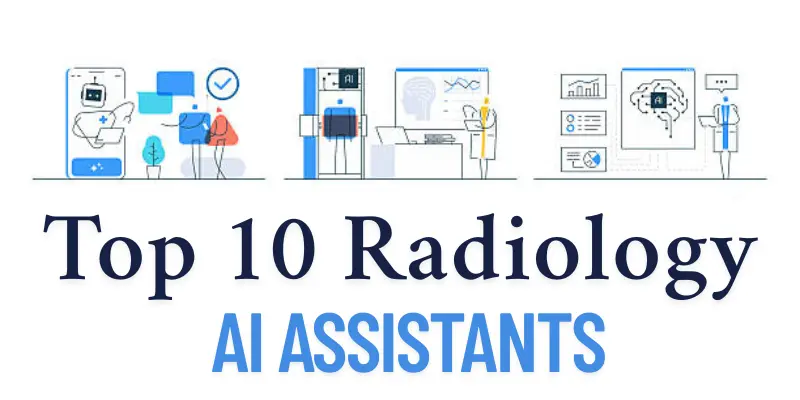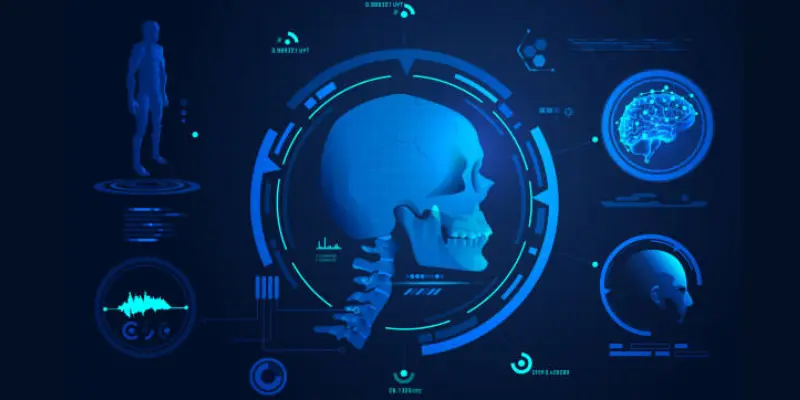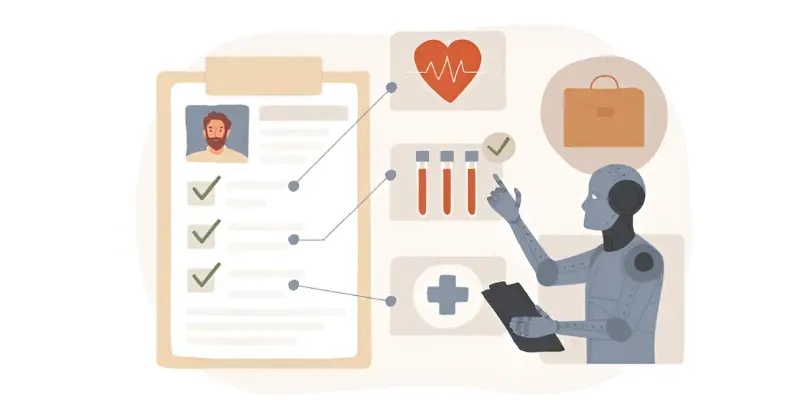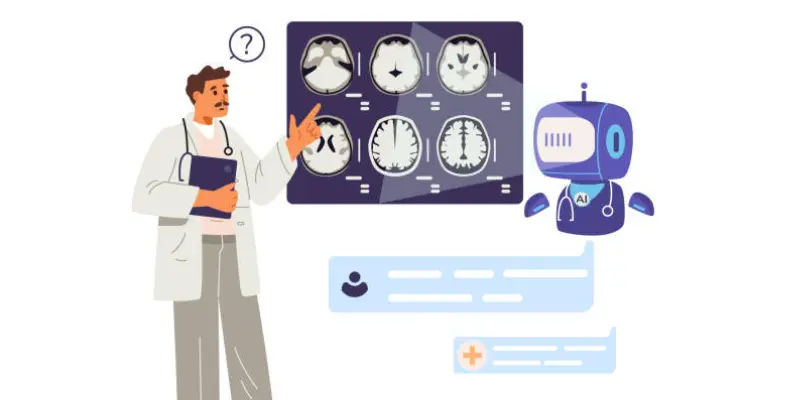Top 10 Radiology AI Assistants Making an Impact in Healthcare
Published: 3 May 2025
Can a computer really help to read X-rays or detect tumors better than a trained doctor? That question confuses many people when they hear about AI in radiology. Radiology departments worldwide are adopting AI at a fast pace. In fact, over 30% of imaging centers now use AI tools to get help in reading scans. These tools save time, reduce errors and boost confidence in diagnosis. In this article, we will look at the Top 10 Radiology AI Assistants making the biggest impact in hospitals and clinics today.

What Makes a Good Radiology AI Assistant?
Not all AI tools are the same. Some are smart, fast, reliable and super helpful. Others may look good but don’t do much in real situations.
So, what makes a Radiology AI Assistant truly useful in healthcare? Let’s look at the key things that matter.
1. It Must Be Easy to Use
Doctors and nurses are already busy. A good AI tool should be simple to learn and quick to use.
No one wants to spend hours reading a manual.
Example: Some AI platforms have a clean dashboard where users just upload scans and get results in seconds.
2. It Should Be Accurate
In radiology, even a small mistake can cause big problems. The best AI tools spot details that humans may miss.
They also help double-check findings so doctors feel more confident.
Think about this: An AI tool that finds tiny lung nodules early can help to start treatment sooner and save lives.
3. Speed Is Important
AI assistants should give results fast. Quick answers mean faster care for patients.
This is helpful in emergencies like spotting a stroke or internal bleeding on a scan.
Example: Some AI tools alert doctors within minutes after finding something unusual in a CT scan.
4. It Should Work Well with Hospital Systems
A good AI assistant should fit smoothly into the tools doctors already use. It should connect with scan machines and patient records easily.
This means less setup time and no need for major changes in how people work.
5. It Should Reduce Errors, Not Create More
The right AI doesn’t just add more data, it helps the doctors avoid mistakes. It points out things they might miss and gives clear suggestions.
Example: If the AI sees something strange, it can flag the scan with a color mark or short note.
✅ Quick Checklist: What to Look for in a Radiology AI Assistant
- Easy to use?
- Gives quick and accurate results?
- Works with your hospital’s system?
- Helps doctors, not replace them?
- Cleared by health regulators?
Top 10 Radiology AI Assistants
AI is becoming a helpful friend in radiology rooms around the world. Remember, It doesn’t replace doctors but it supports them to catch things they may miss and speeds up the process. Below are ten powerful Radiology AI Assistants that are helping hospitals, clinics and imaging centers work better and faster.
Let’s take a look at each one:
- Aidoc
- Zebra Medical Vision
- Qure.ai
- The Radiology Assistant
- Rad AI
- Chatgpt
- Annalise.ai
- Gleamer
- Enlitic
- Lunit INSIGHT
1. Aidoc
Aidoc is a trusted AI tool that helps radiologists to spot urgent problems like strokes, bleeds and clots. It scans images fast and sends alerts so doctors can act quickly. Many hospitals use it to handle emergencies better and save lives faster.
Key Features:
- Detects critical findings in CT scans
- Sends instant alerts to radiologists
- Works with stroke, trauma and chest scans
- Fits easily into hospital systems

2. Zebra Medical Vision
Zebra Medical Vision offers AI tools that scan for many health issues like lung problems, bone loss and liver disease. It helps doctors to find risks early, even before symptoms show. It’s often used in big health programs and screening projects.
Key Features:
- Supports population-wide screenings
- Finds signs of chronic diseases early
- Works on chest, bone and liver images
- Easy to access via the cloud
3. Qure.ai
Qure.ai builds AI tools that work well even in small clinics. It reads chest X-rays and brain scans to find TB, bleeds or infections. It’s widely used in areas with fewer doctors to support faster care.
Key Features:
- Detects TB, brain bleeds and lung issues
- Works offline in remote locations
- Quick and beginner-friendly
- Serving in over 90 countries across 3000+ sites
4. The Radiology Assistant
This platform is more of an educational helper than a diagnostic AI. It gives radiologists clear guides, case examples and images to improve reading skills. It’s loved by medical students and professionals alike.
Key Features:
- Case-based learning modules
- Trusted by radiology educators
- Easy to follow visual guides
- Updated regularly by experts
5. Rad AI
Rad AI helps doctors finish radiology reports faster. It learns how each radiologist writes and then helps fill-in the details automatically. This saves time and reduces burnout for busy healthcare teams.
Key Features:
- Smart report-writing assistant
- Adapts to individual writing styles
- Saves reporting time
- Improves accuracy in reports

6. ChatGPT (Used with Radiology Tools)
ChatGPT itself is not a medical AI but when used with radiology tools, it can explain findings, write summaries or create learning material. Doctors use it to talk more clearly with patients or improve communication.
Key Features:
- Converts scan findings into plain language
- Creates notes, summaries or patient letters
- Useful for training and education
- Customizable for different tasks
7. Annalise.ai
Annalise.ai is a powerful assistant that checks X-rays and CTs for over 100 conditions. It gives clear results and is used to support faster decisions in emergency rooms and hospitals.
Key Features:
- Covers 100+ conditions in one scan
- Works with both chest X-rays and CTs
- Highly accurate with marked findings
- Trusted in emergency care settings
Also Read: Top 10 AI Caregiver Tools in Healthcare 2025
8. Gleamer
Gleamer focuses on finding bone fractures and injuries in X-rays. It’s especially useful in fast-moving clinics and ERs. Its simple alerts help doctors to catch breaks they might miss.
Key Features:
- Detects bone fractures in seconds
- Highlights injuries with color marks
- Fits well into daily hospital routines
- Supports radiologists and ER doctors
9. Enlitic
Enlitic doesn’t read scans directly. Instead, it organizes medical images and makes data ready for AI use. It helps hospitals clean their imaging data and get more value from it.
Key Features:
- Prepares imaging data for AI models
- Improves system speed and access
- Helps to train other diagnostic AIs
- Supports better data quality
10. Lunit INSIGHT
Lunit INSIGHT helps in finding the signs of cancer and TB from chest and breast images. It gives results that are easy to read with clear markings on the scan. It’s approved by major health agencies and used worldwide.
Key Features:
- Detects lung cancer, breast cancer and TB
- FDA- and CE-cleared
- Easy-to-read visual output
- Used in screening programs globally
How These AI Assistants Help Radiologists in Daily Work
Radiologists work with hundreds of medical images every day. This includes X-rays, CT scans and MRIs. It takes time and full attention to find the right answers. But AI assistants make this job much easier.
Let’s look at how these AI tools support radiologists step by step.
1. Faster Diagnosis
AI tools look at scans quickly and find problems in seconds.
For example, Aidoc can spot a brain bleed within a minute.
This speed helps doctors treat stroke or trauma patients right away.
2. Better Accuracy
AI tools don’t get tired. They look at every small detail.
Gleamer, for instance, can spot tiny bone fractures that a tired doctor might miss.
This avoids wrong or missed reports.
3. Less Repetitive Work
Writing reports again and again is boring and tiring.
Tools like Rad AI help to wrap up the reports automatically.
It learns how each radiologist writes and fills in details.
4. Learning and Skill Building
Not all radiologists are experts in every field.
The Radiology Assistant offers guides and case examples.
Even students or new doctors can learn how to read images better.
5. Support in Remote Areas
Some places have very few radiologists.
AI tools like Qure.ai work well even in small clinics.
They help doctors in rural areas to make better decisions.
Looking to expand your research? Read Radiology AI Companies for In-Depth Analysis
6. Teamwork, Not Replacement
AI doesn’t replace doctors. It works with them. Think of AI as a smart helper. It finds signs and the doctor makes the final call. Use AI as your assistant, not your boss.

Tips to Choose the Right Radiology AI Tool
There are many AI tools in radiology today. But not all of them fit your needs. Some work better in big hospitals. Others are great for small clinics. So how do you choose the right one?
Let’s go over a few easy tips to help you pick the best tool.
1. Know Your Needs First
Start by asking: What problem do you want to solve?
- Need help with reading chest X-rays? Try tools like Qure.ai or Lunit INSIGHT.
- Want faster reporting? Rad AI is a great choice.
- Need an educational platform? The Radiology Assistant can help.
Quick Tip: Make a short list of your daily tasks. Then match tools that help with them.
2. Check How Easy It Is to Use
The best tool is one that your team can use every day without stress.
Check it to find answers for these simple questions:
- Is the tool user-friendly?
- Does it need special training?
- Can it be added easily to your current system?
Quick Tip: Choose tools with a clean design and helpful support team.
3. Look for Approval and Accuracy
Good AI tools are tested and approved by health experts.
Check if the tool has FDA approval or CE marking.
Also, see if the tool was tested in real hospitals. You want something that gives accurate results.
Quick Tip: Ask for proof like studies, numbers or user reviews.
4. Think About Your Budget
Some tools cost more than others. But that doesn’t mean they are better.
Look at what you are getting for the price.
- Some tools charge per scan
- Others use a subscription
- A few offer discounts for small clinics
Quick Tip: Don’t overpay for features you don’t need.
5. Check for Support and Updates
Technology keeps changing. Your AI tool should too.
- Does the company offer updates?
- Is help available when something goes wrong?
- Can you reach support quickly?
Quick Tip: Choose AI companies with a strong support team and regular updates.
6. Test It Before You Commit
Many companies offer free trials or demos.
Use this time to see if the tool fits your workflow.
- Try it with real scans
- Get feedback from your team
- See how it performs during busy hours
Quick Tip: Use demo time wisely. Test real cases, not just samples.
Final Thoughts: Choosing the Right Radiology AI Assistant
Radiology is changing fast. AI is no longer just a buzzword, it’s now part of the daily workflow in hospitals and clinics. These smart assistants save time, improve accuracy and help doctors make better decisions. Whether you work in a big city hospital or a small rural clinic, there’s an AI tool out there that can help you. Now you should better know how to choose one, right? If not, let me know in the comments.
From Aidoc’s emergency scan support to Rad AI’s smart reporting, each tool has something special. But remember, AI doesn’t replace radiologists. It works with them to give better care for the patients.
Take your time, test a few tools and choose the one that fits your needs best.
👨⚕️👩⚕️ Want to make your radiology work faster and easier? Maybe it’s time to try one of these AI assistants.
Related Questions About Radiology AI Assistants
Here are frequently asked questions about Radiology AI assistants:
Radiology AI assistants usually range from $50,000-$200,000 per year for a hospital or imaging center, depending on features and usage volume. Some companies offer subscription models based on the number of scans analyzed while others charge a flat fee. Smaller clinics can often get scaled-down versions at lower costs which sometimes start around $1,000-$5,000 monthly.
No, AI won’t replace radiologists in the foreseeable future. AI tools are designed to assist radiologists by handling repetitive tasks and flagging potential issues but they lack the clinical judgment and comprehensive understanding that human doctors provide. The most effective approach is a partnership where AI enhances radiologists’ capabilities rather than replacing their expertise.
Several AI tools, particularly Qure.ai are specifically designed to work in rural and resource-limited settings. These solutions often have offline capabilities, lower hardware requirements and more affordable pricing structures for smaller facilities. Some providers even offer special programs for rural healthcare facilities to make their technology more accessible.
Most modern radiology AI assistants are designed with user-friendly interfaces requiring minimal training, typically 1-2 hours for basic proficiency. The training usually covers how to upload images, interpret AI findings and integrate the tool into existing workflows. Many vendors provide free online tutorials, webinars and ongoing support to ensure staff can use the technology effectively.
Studies show that leading radiology AI tools achieve 85-95% accuracy rates which is comparable to experienced radiologists in specific tasks. In some specialized areas like detecting certain lung nodules or fractures, AI can sometimes exceed human performance due to its consistency. However, radiologists maintain superior overall diagnostic ability when considering the full clinical picture and unusual presentations.
The radiologist always maintains final responsibility for interpretation with AI serving only as a supportive tool. Most systems clearly indicate that findings are AI-generated and require human verification before becoming part of the official medical record. Many platforms also track and learn from corrections, continuously improving their accuracy over time.
Reputable AI radiology assistants comply with healthcare data protection regulations like HIPAA and GDPR. Most solutions encrypt patient data, anonymize images before processing and maintain secure servers with strict access controls. Many providers also offer on-premise deployment options for healthcare facilities with stricter data sovereignty requirements.
Most modern radiology AI assistants are designed to integrate with standard hospital systems through DICOM and HL7 protocols. Vendors typically provide integration services to connect their AI with your Picture Archiving and Communication System (PACS) and Electronic Health Record (EHR). Some systems require specific technical requirements so it’s important to check compatibility before purchasing.
The implementation timeline typically ranges from 2-8 weeks depending on the complexity of your existing systems and the AI solution chosen. Basic cloud solutions can be operational in days while full-scale integrations with on-premise deployment might take longer. Most vendors provide dedicated implementation teams to ensure smooth transitions with minimal disruption to patient care.
Radiology AI tools are regularly updated through both automated learning and manual retraining by the development teams. Most vendors release major updates quarterly based on new research findings and feedback from practicing radiologists. Subscription-based services typically include these updates automatically, ensuring the AI continues to improve and reflect current medical standards.





